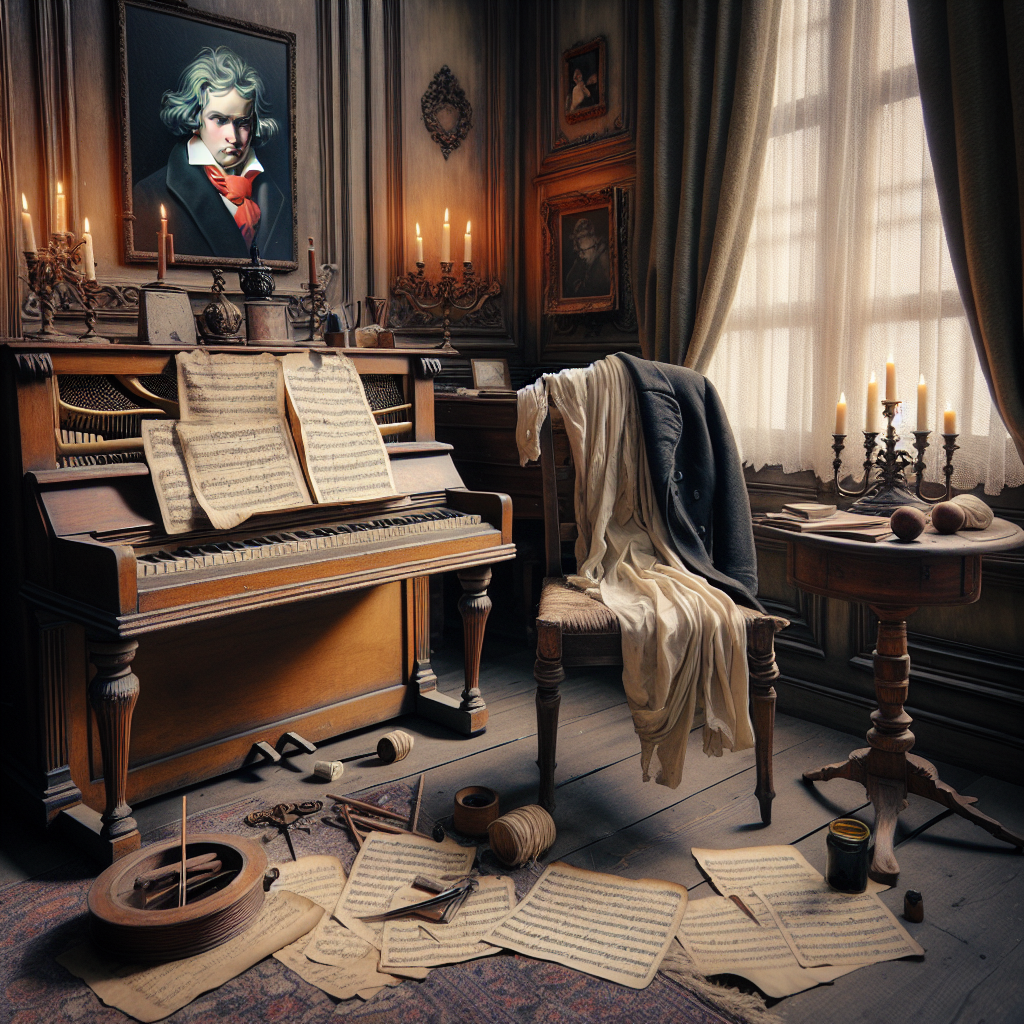
Beethoven’s Student Works – Unveiling His Formative Years
Ludwig van Beethoven, one of the most celebrated composers of Western classical music, remains an enigmatic figure to this day. Music enthusiasts and historians alike continue to explore his life, trying to piece together the journey that led him to create some of the most extraordinary musical works ever written. While much is known about his mature and late compositions, far less attention has been given to his early student works. These pieces, though unpublished and less frequently performed, offer invaluable insights into Beethoven’s youthful experimentation and burgeoning genius.
Born in Bonn, Germany in 1770, Beethoven displayed musical talent at an early age. His father, Johann van Beethoven, was keen to cultivate his son’s abilities, pushing young Ludwig into a rigorous routine of music studies. This early education laid the foundation for Beethoven’s future success, even though it came at the cost of a difficult and often unhappy childhood. His early works, composed during this period of intense learning and discovery, reveal not only his technical prowess but also the evolution of his stylistic and compositional skills.
Understanding Beethoven’s early works is akin to peeking into the raw, unpolished stages of a masterpiece in progress. These compositions are the crucible in which his later, more refined music was forged. They highlight the influences of his teachers, Joseph Haydn and Christian Gottlob Neefe, among others, and show Beethoven’s willingness to depart from conventional norms even as a young musician. In this article, we will delve into the significance of these early pieces, examining their role in his development, the stylistic traits they reveal, and their lasting impact on the world of classical music.
The Influence of Early Teachers
To fully grasp the essence of Beethoven’s student works, it is essential to consider the masters who guided him during his formative years. His first important teacher, Christian Gottlob Neefe, was a pivotal figure in Beethoven’s early musical education. Neefe recognized the young prodigy’s immense talent and took him under his wing, providing him with lessons in composition and keyboard technique. Under Neefe’s tutelage, Beethoven composed some of his earliest works, such as the “Nine Variations on a March by Dressler,” WoO 63, composed when he was just eleven years old.
Beethoven’s move to Vienna in 1792 marked a significant turning point in his education. In Vienna, he studied under the tutelage of Joseph Haydn, one of the most renowned composers of the time. Although their relationship was not without its challenges, Haydn’s influence on Beethoven was unmistakable. During this period, Beethoven composed several important works, including his three early piano sonatas, which were later published as “Opus 2.” These sonatas exhibit a clear departure from the stylistic conventions of his predecessors, signaling the advent of a new and innovative approach to composition.
Another significant influence during Beethoven’s time in Vienna was Johann Georg Albrechtsberger, a renowned contrapuntist. Under Albrechtsberger, Beethoven honed his skills in counterpoint, an intricate form of musical composition that involves the interweaving of independent melodic lines. This training became invaluable in Beethoven’s later works, lending them a complexity and richness that are characteristic of his mature style.
The teachings and influences of these early mentors are discernible in Beethoven’s student works. The pieces he composed during this period reflect a blend of traditional classical forms and innovative ideas, showcasing his ability to absorb and transform the knowledge imparted to him by his teachers. This fusion of old and new laid the groundwork for Beethoven’s later masterpieces, demonstrating his unique ability to merge technical proficiency with creative genius.
Early Compositional Style: Experimentation and Innovation
Beethoven’s early works are marked by a spirit of experimentation and innovation. Even as a young composer, he displayed a remarkable willingness to push the boundaries of traditional forms and techniques. This propensity for experimentation is evident in many of his unpublished student works, which explore various musical structures and ideas that would later become central to his mature style.
One notable example of this experimentation is the set of three Piano Quartets, WoO 36, composed between 1785 and 1786. These quartets, written when Beethoven was just fifteen years old, are early demonstrations of his ability to blend different instrumental voices in a cohesive and dynamic manner. While they adhere to classical forms, they also reveal a youthful exuberance and a keen sense of musical dialogue. The interplay between the piano and strings in these quartets foreshadows the sophisticated interplay that would characterize his later chamber works.
Another early piece that showcases Beethoven’s innovative spirit is the “Rondo for Piano in C Major,” WoO 48. Composed in 1795, this work is an early testament to his ability to imbue traditional forms with a fresh and distinctive voice. The rondo, a form characterized by the recurring return of a principal theme, is handled with a deftness that belies Beethoven’s youth. The piece features unexpected modulations and rhythmic variations, elements that would become hallmarks of his mature compositions.
In addition to his instrumental works, Beethoven’s early vocal compositions also demonstrate his willingness to explore new ideas. His song “Adelaide,” Op. 46, composed in 1795, is an exquisite example of his early vocal writing. The piece, a setting of a poem by Friedrich von Matthisson, exhibits a lyrical beauty and an emotional depth that would later be fully realized in his mature Lieder. The interplay between the vocal line and the accompaniment in “Adelaide” is particularly striking, highlighting Beethoven’s growing mastery of text setting and expressive nuance.
These early works, while not as polished as his later masterpieces, are invaluable in understanding Beethoven’s development as a composer. They provide a glimpse into his creative process, revealing the seeds of innovation that would eventually blossom into the ground-breaking compositions for which he is renowned. Through these pieces, we see the young Beethoven not only absorbing the lessons of his mentors but also forging his own path, driven by an insatiable curiosity and a relentless drive to challenge the status quo.

The Evolution of Beethoven’s Musical Voice
As Beethoven matured, his early student works laid the foundation for the evolution of his unique musical voice. These formative pieces provided him with a playground for experimentation, allowing him to test the boundaries of classical forms and develop his own distinctive style. This period of exploration was crucial in shaping the innovative composer that Beethoven would become.
One of the key elements that began to emerge in Beethoven’s early works was his use of dynamics and contrasts. Unlike many of his contemporaries, Beethoven was not content to adhere to the established norms of subtle dynamic changes. Instead, he began to employ more dramatic shifts in volume and intensity, creating a sense of heightened emotional expression. This can be seen in his early piano sonatas, where sudden changes in dynamics add a new level of excitement and unpredictability to the music.
Another hallmark of Beethoven’s developing style was his use of rhythmic innovation. From an early age, he showed a keen interest in rhythmic complexity and irregularity. In works like the “Piano Sonata in C Minor,” Op. 10 No. 1, composed in 1798, Beethoven’s penchant for syncopation and offbeat accents becomes evident. These rhythmic innovations would later be fully realized in his mature works, contributing to the distinctive character of his music.
Beethoven’s harmonic language also began to evolve during this period. He started to experiment with new and unconventional chord progressions, moving away from the predictable harmonic patterns of his predecessors. This exploration of harmony is particularly notable in his early string quartets, where unexpected modulations and chromaticism add depth and complexity to the music. The “String Quartet in F Major,” Op. 18 No. 1, composed around 1798-1800, is a prime example of this harmonic experimentation.
Perhaps one of the most significant aspects of Beethoven’s evolving musical voice was his increasing emphasis on thematic development. Rather than relying on simple repetitive motifs, Beethoven began to explore the potential of developing and transforming thematic material throughout a piece. This approach allowed him to create works with a greater sense of cohesion and organic growth. The “Piano Sonata in E-flat Major,” Op. 7, composed in 1796-1797, showcases Beethoven’s early attempts at thematic development, a technique that would become a cornerstone of his mature compositions.
In summary, Beethoven’s early student works were instrumental in the evolution of his musical voice. They provided him with a foundation of technical proficiency and a platform for creative exploration. Through these pieces, Beethoven honed his skills in dynamics, rhythm, harmony, and thematic development, setting the stage for the revolutionary composer he would become. The innovations and experimentation found in his early works are a testament to his restless creativity and his unwavering commitment to pushing the boundaries of musical expression.
Beethoven’s Early Influence and Legacy
Although Beethoven’s early student works may not be as well-known or frequently performed as his later masterpieces, they played a crucial role in shaping his legacy as one of the greatest composers in history. These formative pieces provide invaluable insights into his development as a musician and composer, offering a glimpse into the early influences that would leave an indelible mark on his mature style.
One of the most significant aspects of Beethoven’s early legacy was his ability to bridge the gap between the Classical and Romantic periods. His early works, while rooted in the classical traditions of his time, also hint at the emotional intensity and innovative spirit that would come to define the Romantic era. This ability to transcend the boundaries of his time and anticipate future developments in music is a testament to his visionary genius.
The influence of Beethoven’s early works extended beyond his own compositions. Many of his contemporaries and successors were inspired by his innovative approach to composition, drawing inspiration from his willingness to push the boundaries of traditional forms and techniques. Composers such as Franz Schubert, Robert Schumann, and Johannes Brahms, among others, looked to Beethoven’s early works as a source of inspiration and a model for their own creative endeavors.
Beethoven’s early string quartets, in particular, had a lasting impact on the development of this genre. His exploration of harmonic complexity, dynamic contrasts, and thematic development in these works set a new standard for string quartet composition. Later composers, including Felix Mendelssohn and Dmitri Shostakovich, would build upon Beethoven’s innovations, further expanding the expressive potential of the string quartet.
In the realm of piano music, Beethoven’s early works also left a significant mark. His piano sonatas, with their technical demands and expressive depth, became a cornerstone of the piano repertoire. Pianists continue to study and perform these early sonatas, recognizing their importance in the evolution of the instrument’s literature. The virtuosic and expressive possibilities explored in these works paved the way for later developments in piano music, influencing composers such as Franz Liszt and Frédéric Chopin.
In conclusion, Beethoven’s early student works are a testament to his formative years of experimentation and innovation. They provide a window into the young composer’s creative process, revealing the seeds of his later achievements. The influence of these early works extends far beyond Beethoven’s own compositions, leaving a lasting legacy that continues to inspire musicians and composers to this day. By studying and appreciating these early pieces, we gain a deeper understanding of Beethoven’s journey and the profound impact he had on the world of music.